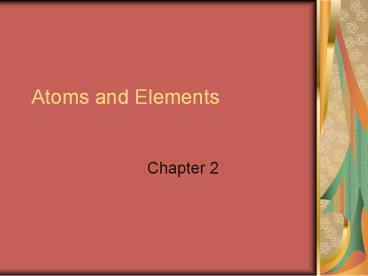Atoms and Elements - PowerPoint PPT Presentation
Title:
Atoms and Elements
Description:
Atoms and Elements Chapter 2 Learning Objectives Students understand: Composition and structure of atoms and the terms atomic number and mass number The various ... – PowerPoint PPT presentation
Number of Views:68
Avg rating:3.0/5.0
Title: Atoms and Elements
1
Atoms and Elements
- Chapter 2
2
Learning Objectives
- Students understand
- Composition and structure of atoms and the terms
atomic number and mass number - The various representations of masses of atoms
- Composition of isotopes
- Importance of Coulombs law
- Mole concept and molar mass application
- How mass spectrometry is used
3
Learning Objectives
- Students will be able to
- Carry out calculations relating atomic weights,
isotopic masses, and isotopic abundances - Carry out calculations involving masses, moles,
and numbers of particles - Interpret, predict, and write formulas for ionic
and molecular compounds - Determine empirical and molecular formulas and
percent composition
4
2.1 Atomic Structure
- Electrons
- Protons
- Neutrons
- Atoms have no net charge. The number of
electrons outside the nucleus equals the number
of protons within the nucleus.
5
2.2 Atomic Number and Atomic Mass
- All atoms of a given element have the same number
of protons in the nucleus. - Number of protons in the nucleus is its atomic
number. - One atomic mass unit (1 u) is one twelfth of the
mass of an atom of carbon with six protons and
six neutrons. - 1 u 1.661x10-24 g
6
Mass Number
- protons and neutrons have mass of approximately 1
u (electrons are about 1/2000 of this mass) - sum of protons and neutrons is defined as the
mass number - symbolized by an A
- can be expressed as sodium-23 or 23Na
7
2.3 Isotopes
- Data from mass spectroscopy demonstrate evidence
that Daltons model is incorrect these data then
require a modification of that model. - These data demonstrate direct evidence of
different isotopes from the same element.
8
Isotopes
- atoms with same atomic number but different mass
numbers are called isotopes, named by mass number - isotopes of hydrogen each have separate names
- protium hydrogen with one proton
- deuterium 2H or heavy hydrogen (1 neutron)
- tritium 3H radioactive hydrogen (2 neutrons)
9
Isotope Abundance
- percent abundance is the number of atoms of a
given isotope divided by the total number of all
isotopes of that element multiplied by 100 - the atomic mass of an element is affected by the
percent abundance of each isotope
10
2.4 Atomic Weight
- the atomic weight is the average mass of a
representative sample of atoms - usually closer to the mass of the most abundant
isotope(s) - Atomic mass is the mass of an atom at rest.
Relative atomic mass (atomic weight) is the
average of the atomic masses of all the elements
isotopes.
11
Practice Problems
- Review and Check for Section 2-4
- P. 52
12
2.5 The Periodic Table
- Mendeleev discovered that elements with similar
properties appeared in a regular pattern when
organized by increasing atomic mass. - law of chemical periodicity the properties of
the elements are periodic functions of atomic
number
13
The Periodic Table
- vertical columns of groups or families have
similar characteristics - A groups are main group elements
- B groups are the transition elements
- horizontal rows are called periods
- metals, nonmetals, metalloids
- allotropes are different forms of the same
element (diamond, graphite, bucky balls)
14
Overview of Elements
- Group 1A alkali metals
- Group 2A alkaline earth metals
- Group 3A B, Al, Ga, In, Tl
- Group 4A C, Si, Ge, Sn, Pb
- Group 5A N, P, As, Sb, Bi
- Group 6A O, S, Se, Te, Po
- S, Se, Te are called the chalcogens
- Group 7A halogens
- Group 8A noble gases
15
Overview of Elements
- The Transition Elements
- B group elements all metals
- reactivity varies
- commercial uses (structures, paints, vehicles,
coins, batteries) - lanthanides and actinides are below the table
16
Homework for Chapter 2
- After reading sections 2.1 2.5, you should be
able to do the following problems - P. 95a-b (10-11, 18, 23-24, 32)
- Be familiar with the key experiments involved in
the development of the current atomic model
(p.54-55)































